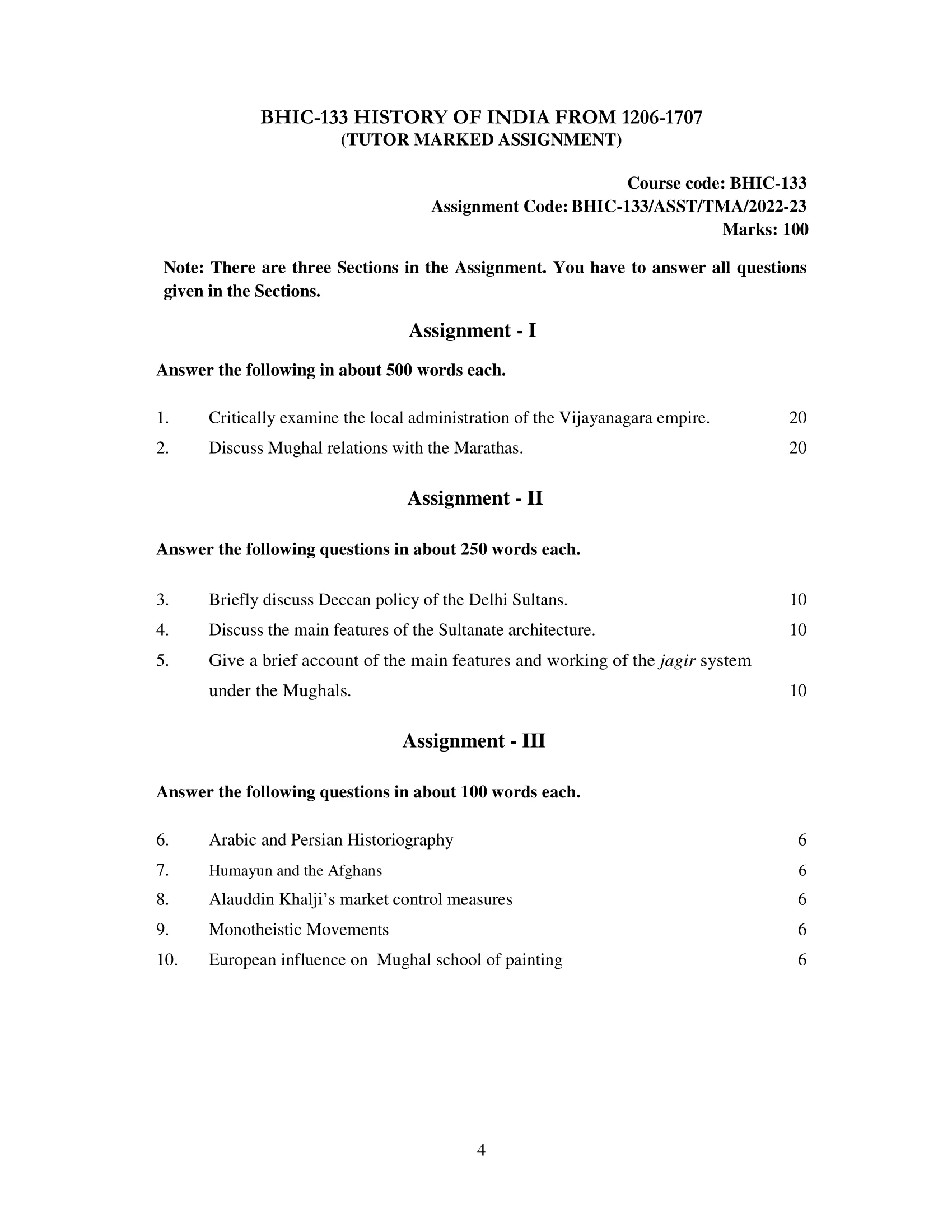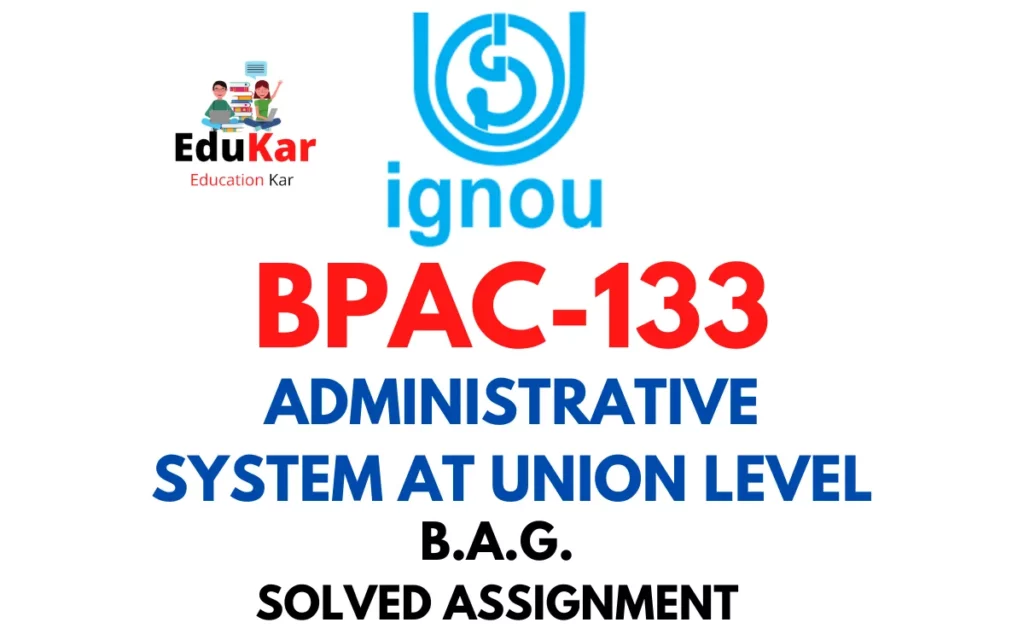Contents
- 1 Assignment – I
- 2 Answer the following in about 500 words each.
- 3 1. Critically examine the local administration of the Vijayanagara empire.
- 4 2. Discuss Mughal relations with the Marathas.
- 5 Assignment – II
- 6 Answer the following questions in about 250 words each.
- 7 3. Briefly discuss Deccan policy of the Delhi Sultans.
- 8 4. Discuss the main features of the Sultanate architecture.
- 9 5. Give a brief account of the main features and working of the jagir system under the Mughals.
- 10 Assignment – III
- 11 Answer the following questions in about 100 words each.
- 12 6. Arabic and Persian Historiography
- 13 7. Humayun and the Afghans
- 14 8. Alauddin Khalji’s market control measures
- 15 9. Monotheistic Movements
- 16 10. European influence on Mughal school of painting

| Title | BHIC-133 |
| University | IGNOU |
| Degree | Bachelor Degree Programme |
| Course Code | BHIC-133 |
| Course Name | History Of India From 1206-1707 |
| Programme Name | Bachelor of Arts (General) |
| Programme Code | BAG |
| Total Marks | 100 |
| Year | 2022-2023 |
| Language | English |
| Assignment Code | BHIC-133/ASST/TMA/2022-23 |
| Last Date for Submission of Assignment: | For June Examination: 31st March For December Examination: 30th September |

Assignment – I
Answer the following in about 500 words each.
1. Critically examine the local administration of the Vijayanagara empire.
Ans: The Vijayanagara empire was one of the largest and most powerful empires in medieval India. It was established in the 14th century and lasted until the 16th century. The empire was characterized by its strong centralized administration, which was responsible for maintaining law and order, collecting taxes, and overseeing public works. In this essay, we will critically examine the local administration of the Vijayanagara empire, focusing on its strengths and weaknesses.
One of the strengths of the local administration of the Vijayanagara empire was its efficient tax collection system. The empire had a well-organized and efficient system of tax collection, which allowed the central government to raise the necessary funds to maintain its army and infrastructure. The empire levied taxes on various items, such as crops, trade, and commerce, and these taxes were collected by local officials who were responsible for maintaining accurate records and ensuring that taxes were paid promptly.
Another strength of the local administration of the Vijayanagara empire was its effective law and order system. The empire maintained a well-trained army that was responsible for maintaining law and order throughout the empire. This army was well-disciplined and highly trained, and it was able to respond quickly to any threats to the security of the empire. Additionally, the empire had a well-developed judicial system that allowed for the fair and impartial resolution of disputes.
However, there were also several weaknesses in the local administration of the Vijayanagara empire. One of the major weaknesses was the lack of accountability among local officials. Many local officials were appointed by the central government, and they were often not held accountable for their actions. This lack of accountability allowed for corruption to flourish, and it led to widespread abuses of power by local officials.
2. Discuss Mughal relations with the Marathas.
Ans: The Mughal Empire and the Maratha Empire were two of the largest and most powerful empires in India during the late medieval and early modern period. Despite having some similarities in their political and cultural systems, the relationship between the two empires was complex and often fraught with conflict.
During the early part of the Mughal rule in India, the Marathas were a minor power and were not seen as a major threat by the Mughals. However, as the Maratha power grew and expanded, the Mughals began to view them as a challenge to their rule. In 1680, the Maratha leader Shivaji declared himself the Chhatrapati, or king, of the Maratha kingdom, which brought him into direct conflict with the Mughals.
The first major conflict between the Mughals and Marathas took place in 1682, when the Mughal emperor Aurangzeb sent an army to defeat Shivaji. The Maratha forces were able to resist the Mughal attack, but this conflict marked the beginning of a long and bitter struggle for control of India between the two empires.
Throughout the late 17th and early 18th centuries, the Mughals and Marathas engaged in a series of battles and negotiations. The Marathas were often able to gain the upper hand due to their guerrilla tactics and the support they received from local rulers and nobles. However, the Mughals were also able to make significant gains, particularly during the reign of Aurangzeb.
One of the most significant events in the history of Mughal-Maratha relations was the Treaty of Purandar, signed in 1665 between Aurangzeb and the Maratha leader Jai Singh. This treaty marked a temporary ceasefire between the two empires and allowed Aurangzeb to focus his attention on other areas of his empire. However, the treaty did not bring lasting peace, and the conflict between the Mughals and Marathas resumed soon after.
As the power of the Mughal Empire declined in the 18th century, the Marathas continued to grow and expand. By the mid-18th century, the Maratha Empire was one of the dominant powers in India, controlling large parts of the country and challenging the authority of the Mughal emperor.
The final major conflict between the Mughals and Marathas took place in the early 19th century, during the reign of the Maratha leader Baji Rao. Baji Rao was able to defeat the Mughal army and secure a significant victory for the Maratha Empire. This conflict marked the end of the Mughal Empire and the beginning of the Maratha Empire as the dominant power in India.
Assignment – II
Answer the following questions in about 250 words each.
3. Briefly discuss Deccan policy of the Delhi Sultans.
Ans: The Deccan policy of the Delhi Sultans refers to the strategy adopted by the Sultanic rulers of the Delhi Sultanate towards the southern region of the Deccan plateau in India. The Deccan region was home to several Hindu kingdoms, which posed a constant challenge to the authority of the Delhi Sultans. The Deccan policy was aimed at securing the northwestern frontier of the Delhi Sultanate and maintaining control over the southern regions through military campaigns, alliances, and administrative measures.
The first Delhi Sultan, Qutb-ud-din Aibak, led several expeditions to the Deccan in the early 13th century. However, it was only during the reign of Alauddin Khilji that the Deccan policy was formalized and implemented on a large scale. Khilji launched several military campaigns against the Hindu kingdoms of the Deccan and established a network of fortresses to secure his control over the region.
Under the Deccan policy, the Delhi Sultans also adopted a policy of conciliation towards the local Hindu population, which allowed them to maintain their control over the region with relatively low levels of resistance. They also adopted a policy of religious tolerance, which allowed the Hindu population to continue practicing their religion and customs.
However, the Deccan policy was not always successful, and the Hindu kingdoms of the region often revolted against the Delhi Sultanate. In the late 14th century, the Bahmani Sultanate was established in the Deccan, which further weakened the control of the Delhi Sultans over the region.
4. Discuss the main features of the Sultanate architecture.
Ans: The Sultanate architecture was the dominant architectural style during the Delhi Sultanate period in India, which lasted from the 13th to the 16th century. The style was characterized by a fusion of Indo-Islamic, Persian, and Central Asian architectural elements and is considered to be the earliest expression of Islamic architecture in India. The main features of the Sultanate architecture can be broadly categorized as follows:
- Tombs: The most prominent feature of the Sultanate architecture was the tomb, which was usually constructed in the memory of a ruler or a noble. These tombs were typically large and imposing structures, built with red sandstone and decorated with intricate carvings and calligraphy. The most famous examples of Sultanate tombs are the Alai Darwaza and the tomb of Iltutmish in Delhi.
- Mosques: Mosques were another important feature of the Sultanate architecture and were built to serve the religious needs of the Muslim community. These structures were typically large, open spaces with a central dome and smaller domes on the sides. The walls of the mosque were often decorated with intricate carvings and calligraphy, and the interior was lined with marble.
- Palaces: The Delhi Sultans lived in grand palaces, which were often sprawling structures with large courtyards and multiple buildings. The palaces were typically built with red sandstone and decorated with intricate carvings, jaalis (stone screens), and lush gardens. Some of the famous examples of Sultanate palaces are the Tughlaqabad Fort and the Qila-i-Kuhna Masjid in Delhi.
- Gates: The Sultanate architecture was also characterized by the use of grand gates, which served as the entrance to cities, forts, and palaces. These gates were often decorated with intricate carvings and calligraphy, and were usually made of red sandstone. The most famous examples of Sultanate gates are the Alai Darwaza in Delhi and the Bahmani Gates in the Deccan.
5. Give a brief account of the main features and working of the jagir system under the Mughals.
Ans: The jagir system was a form of land revenue administration that was prevalent in India during the Mughal era. The word “jagir” means “a grant of land” and referred to a revenue-generating estate that was granted to a nobleman or a military officer by the emperor in return for their services. The main features and workings of the jagir system are as follows:
- Grant of Land: The jagir system involved the grant of a portion of the empire’s revenue-generating land to nobles and military officers in return for their services. These grants were usually made for a specified period of time, after which the jagir would be reassigned to someone else.
- Revenue Collection: The jagir holder was responsible for collecting revenue from the land and paying a fixed portion of it to the emperor. The jagir holder was also responsible for maintaining law and order in the area and for providing troops for the emperor’s army in times of need.
- Hierarchy: The jagir system was hierarchical, with the highest-ranking nobles receiving the largest jagirs. Lower-ranking nobles and military officers received smaller jagirs, and the poorest nobles and soldiers received no jagirs at all.
- Transferability: The jagir system was transferable, and jagirs could be bought and sold or transferred from one person to another. This allowed for the creation of a market for jagirs, which helped to distribute wealth more evenly throughout the empire.
- Role in Mughal Administration: The jagir system played a key role in the Mughal administration, as it allowed the emperor to reward his most loyal and capable nobles and military officers. The jagirs also provided the Mughal state with a stable source of revenue, which helped to finance its military campaigns and other expenses.
Assignment – III
Answer the following questions in about 100 words each.
6. Arabic and Persian Historiography
Ans: Arabic and Persian historiography refers to the writing and study of the history of the Arab and Persian-speaking peoples. These cultures have a rich tradition of historical writing, with many important works being produced over the centuries. Arabic and Persian historians often wrote in a narrative style, incorporating biographical sketches and accounts of key events and figures. They also made use of primary sources, including inscriptions, coins, and other artifacts, to help reconstruct the past. Some of the most famous works of Arabic and Persian historiography include the “Tarikh al-Tabari,” a comprehensive history of the Arab world, and the “Shahnameh,” a legendary history of Persia written by the poet Ferdowsi. These works have played an important role in shaping the cultural identity of the Arab and Persian-speaking peoples, and continue to be widely read and studied to this day.
7. Humayun and the Afghans
Ans: Humayun, the second Mughal emperor of India, had a tumultuous relationship with the Afghan tribes that inhabited the northern regions of the Mughal Empire. During his early reign, Humayun faced numerous rebellions and invasions from Afghan chiefs who sought to establish their independence from the Mughal rule. Despite several military campaigns, Humayun was unable to fully subdue the Afghan rebels and was eventually forced to flee from the empire in 1540. He returned to India 15 years later with the support of the Persian ruler, Shah Tahmasp, and was able to reestablish Mughal control over much of the northern regions. However, Humayun’s relationship with the Afghan tribes remained fragile and his son, Akbar, faced several challenges from Afghan chiefs during his own reign. Despite these difficulties, the Mughals were eventually able to secure their hold over the northern regions and the Afghan chiefs were gradually integrated into the Mughal administrative system.
8. Alauddin Khalji’s market control measures
Ans: Alauddin Khalji, who ruled the Delhi Sultanate in the late 13th and early 14th centuries, implemented a number of market control measures to regulate trade and commerce in the empire. He established a centralized market system, known as the Sarais, to monitor and control the prices of goods and to prevent hoarding and black-market activities. He also introduced a market tax, known as the Chauth, which was collected from merchants and used to support the army. Alauddin Khalji also implemented strict regulations on the production and sale of goods, and appointed officials to enforce these regulations. In addition, he established a system of weights and measures to ensure fair trade practices. These measures helped to increase the efficiency of the market and ensured that the state was able to effectively control the flow of goods and resources. Despite their effectiveness, these measures were also criticized for their harshness and for their impact on the livelihoods of merchants and traders.
9. Monotheistic Movements
Ans: Monotheistic movements refer to religious or philosophical beliefs that worship a single, all-powerful deity. These movements have had a significant impact on the development of Western and Middle Eastern civilizations. Some of the most influential monotheistic movements include Judaism, Christianity, and Islam. These religions all worship a single deity and believe in a moral code that guides human behavior. They also share a belief in the afterlife, the idea that a person’s actions in life will determine their fate after death. Monotheistic movements have often been at the center of social, political, and cultural change, inspiring reforms and shaping the values and beliefs of entire societies. Despite their differences, these movements have had a lasting impact on the world and continue to shape the religious and cultural landscape of many countries.
10. European influence on Mughal school of painting
Ans: European influence on Mughal painting can be traced back to the 16th century, when Portuguese traders and missionaries arrived in India and introduced European painting styles and techniques to the Mughal court. The Mughals, who were known for their love of art and architecture, quickly incorporated these new styles into their own tradition of painting. The result was a unique fusion of Indian and European elements, known as the Mughal school of painting. European influence can be seen in the use of perspective, the depiction of landscapes, and the incorporation of European-style portraits into traditional Mughal paintings. This fusion of styles helped to create a new, distinctive form of Indian art that remains popular to this day.
How to Download BHIC-133 Solved Assignment?
You can download it from the www.edukar.in, they have a big database for all the IGNOU solved assignments.
Is the BHIC-133 Solved Assignment Free?
Yes this is absolutely free to download the solved assignment from www.edukar.in
What is the last submission date for BHIC-133 Assignment?
For June Examination: 31st March, For December Examination: 30th September















